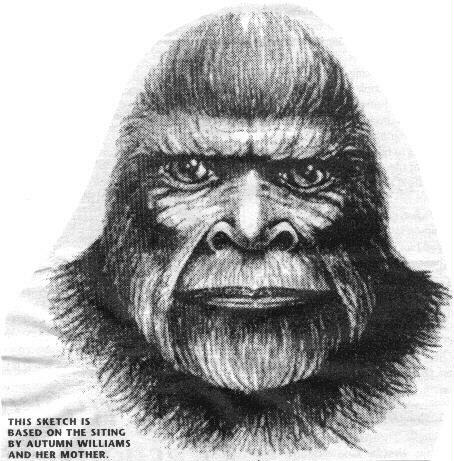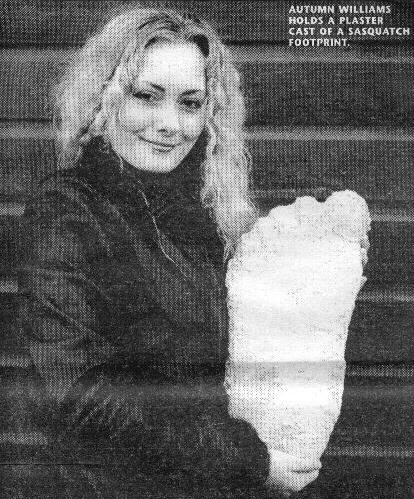Lane County, Oregon - 28 Sightings of Bigfoot
by Joseph Liberman
Beauty
and the Bigfoot
With 28 sightings in Lane County alone, it's time for taking Sasquatch
seriously...
 Her
hand trembles and tears edge her eyes as Autumn Williams picks up the
small framed portrait she has just dropped tumbling onto a coffee mug
in Starbucks on 18th Street. The picture shows a rendition of her personal
encounter with a Sasquatch, and she apologizes for still being so emotional
about it. After all, at the age of 3, a seven-foot-tall Bigfoot can leave
a powerful impression.
Her
hand trembles and tears edge her eyes as Autumn Williams picks up the
small framed portrait she has just dropped tumbling onto a coffee mug
in Starbucks on 18th Street. The picture shows a rendition of her personal
encounter with a Sasquatch, and she apologizes for still being so emotional
about it. After all, at the age of 3, a seven-foot-tall Bigfoot can leave
a powerful impression.
Twenty-five years later she might be dismissing that memory as a toddler's
overactive imagination had her mother not been by her side, squeezing
her hand tight and telling her in slow, measured tones to walk, don't
run, back toward their cottage in the woods. The rest of that day was
spent indoors and under the covers, but that was long before she learned
the truth - or as close to what Bigfoot investigators can call the truth
- about these semi-legendary "wildmen" of the woods. A full
accounting of what she and others have discovered is on her new Eugene
based website (www.oregonbigfoot.com). "This is the first website pooling together and organizing a chronological
listing of incidents in a single region," she explains. "Until
now you could find a report ill a book, then a completely different one
on a website, and it would turn out they were in the same forest a day
apart but no one knew that because no one was compiling a central clearing
house. This way the two reports serve to authenticate each other."
Autumn has compiled 284 statewide listings in all, with the largest number
of county sightings in Clackamas (66) and the second highest (28) being
right here in Lane County. "This reflects more where the available
researchers are located, rather than where the Sasquatch may be," Williams says.
Autumn is doing all this at her own expense; the information on her site
is offered free. "We compile it from other websites, books, and personally
gathered reports," she
says. "And we give credit where it is due. We are not to rip anybody
off and we offer easy links onto lots of other sites. We want to provide
a comprehensive look at sightings in one area. Since we live and work
in Lane County and research all over the state, we decided that Oregon
was as good a place as any to start."
Her goal is to encourage the reporting of as many encounters as possible,
including any that, like hers, remained on the dusty shelves of memory
or in old photo albums for years. To that end, she will be speaking of
her research at the Bigfoot Art Show opening at Feinstein's Museum of
Unfine Art (see Friday, May 3 Calendar).
Getting back to her own childhood experience, I ask Williams if she could
be certain now that she and her mom were not startled by a bear risen
up on its hind legs. Although she lives in Eugene, Autumn's sighting took
place in rural Washington state where she spent the first few years of
her life. "Bears do not have long legs, proportional like humans,"
she counters, "nor faces with eyes this big." She holds her
fingers in a circle that could Probably encompass a baseball.
"And there were two of them," she continues. "I recall
thinking how the smaller one was kind of like me standing next to my mom.
The smaller one was fawn-colored and the big guy was very dark-haired.
But it was the larger one's eyes that I'll never forget. His eyes looked
like a cross between human and cat, enormous and slightly convex, like
there was a thick lens over them. When we made eye contact, I sensed intelligence,
yet there was something surreal and hypnotic."
Where's the Proof?
To skeptics and critics, who probably outnumber firm believers by a fair
margin, the point of contention is pure and simple: Show us the proof
Where is a carcass or even fragmentary remains? Why does so little reliable
photographic documentation exist? How can we separate the real reports
from the hoaxes? Autumn has come-backs for all these questions.
"Have you ever tried to photograph a bear in the wild?" she
responds on her website. "Wait ... have you ever even SEEN a bear
in the wild? How about photographing a bear who walks on two legs and
who can tiptoe? How about trying to take a picture of a bear who's standing
behind dense vegetation, in the dark, and can see you, but you can't see
it, and its primary method of survival is its ability to avoid people
with guns by being very quiet and clever?"
As to physical remains, well, it's a much bigger spread of heavily forested
land out there than most people realize. No hunter in modern times has
ever reported shooting a Bigfoot and those who say they had the opportunity
to do so, thankfully held back. Further, if the critters are human enough,
maybe they have their own methods and rituals of burial.
One of the associations that helps feed the Oregon site states, "...
the public often assumes that Bigfoot research is the tongue-in-cheek
pursuit of a solitary, fictional tabloid character. Nothing could be further
from the truth," pointing out that while a majority of Americans
will profess religiously based beliefs in unscientific and miraculous
events and beings that they have no objective proof of, these same people
will summarily "ridicule" honest-eyewitnesses to these animals,
even if those eyewitnesses are their most trusted family members."
The Hoax Factor
When it comes to hoaxes, Autumn is ready to shoot 'em down and speaks
disparagingly over some of the photos and videos out there, including
a few that got indirectly linked into her site. By and large, however, "fraudulent reports become obvious'' and as another link, Bigfoot
Encounters, warns, "Investigating the Sasquatch is a sure way of
consuming money, not earning it. Any interest in this field motivated
by financial gain is misplaced."
The Bigfoot Encounters' Newsletter goes on to say, "Tabloid journalism
created a pattern that has driven the entire subject of these creatures
into disrepute.., we treat the Sasquatch as a species of a very large,
hirsute bipedal hominid."
Some of the monikers that these critters have been named are, "Sasquatch"
which is the Canadian term for these animals. It is a derivative of the
Coast Salish Indian word "Sesquac" meaning "wild man."
Various Indian tribes across North America have their own terms, such
as "Omah," "Windego," "Yeahoh," "Tsiatko,"
"Boqs," and "Rugaru." Early white settlers in various
regions had their own regional names, such as "Skookums," "Skunk
Apes!' "Swamp Boogers," and "Mountain Devils."
Just Up the River
 There
are plenty of reports from one and two centuries back. One of the more
recent items on Williams' Lane County list took place in July 2000 just
past McKenzie Bridge. A Springfield man hiking over Boulder Creek ridge, "smelled a bad odor... looked around up-wind, and there some 20 feet
away stood an eight-foot upright creature in about four feet of brush
against the edge of a darker fir forest." He described the animal
as having huge wide shoulders, long arms, covered all over with dark,
almost black hair, with reddish highlights. Four to six-inch-long hair,
not furry or soft looking, covered the entire body, head, and limbs.
There
are plenty of reports from one and two centuries back. One of the more
recent items on Williams' Lane County list took place in July 2000 just
past McKenzie Bridge. A Springfield man hiking over Boulder Creek ridge, "smelled a bad odor... looked around up-wind, and there some 20 feet
away stood an eight-foot upright creature in about four feet of brush
against the edge of a darker fir forest." He described the animal
as having huge wide shoulders, long arms, covered all over with dark,
almost black hair, with reddish highlights. Four to six-inch-long hair,
not furry or soft looking, covered the entire body, head, and limbs.
Autumn counsels anyone who is serious about going Bigfoot spotting to, "not allow firearms, stun guns, tranq guns or any other weapons on
research trips. Spend time in the woods in the dark, if you're brave enough.
Learn to be quiet." And while encountering a Sasquatch "can
certainly be unnerving or sometimes terrifying, in nearly all cases the
creatures will avoid confrontation, using creative means to discourage
a witness's continued presence in that area by screaming, throwing small
objects, shaking trees and stomping."
"Don't panic," Autumn advises, "What many researchers tout
as examples of aggression are simply Bigfoot's way of saying 'go away.'" ·
For further info,
visit www.oregonbigfoot.com
or contact Bob and Autumn Williams
P.O. Box 25512
Eugene Oregon 97402
Back to What's New?
Back to Newspaper & Magazine Articles
Home/Main
Portions of this website are reprinted and sometimes edited to fit the standards of this website under the Fair Use Doctrine of International Copyright Law
as educational material without benefit of financial gain.
http://www4.law.cornell.edu/uscode/17/107.html
This proviso is applicable throughout the entire Bigfoot Encounters Website